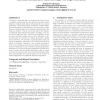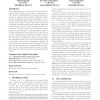7413 search results - page 1417 / 1483 » Using Specularities for Recognition |
KDD
2006
ACM
14 years 8 months ago
2006
ACM
Correlation clustering aims at grouping the data set into correlation clusters such that the objects in the same cluster exhibit a certain density and are all associated to a comm...
KDD
2006
ACM
14 years 8 months ago
2006
ACM
Several algorithms have been proposed to learn to rank entities modeled as feature vectors, based on relevance feedback. However, these algorithms do not model network connections...
KDD
2006
ACM
14 years 8 months ago
2006
ACM
Mining frequent patterns is a general and important issue in data mining. Complex and unstructured (or semi-structured) datasets have appeared in major data mining applications, i...
KDD
2004
ACM
14 years 8 months ago
2004
ACM
Many automated learning procedures lack interpretability, operating effectively as a black box: providing a prediction tool but no explanation of the underlying dynamics that driv...
KDD
2003
ACM
14 years 8 months ago
2003
ACM
The goal of clustering is to identify distinct groups in a dataset. The basic idea of model-based clustering is to approximate the data density by a mixture model, typically a mix...


